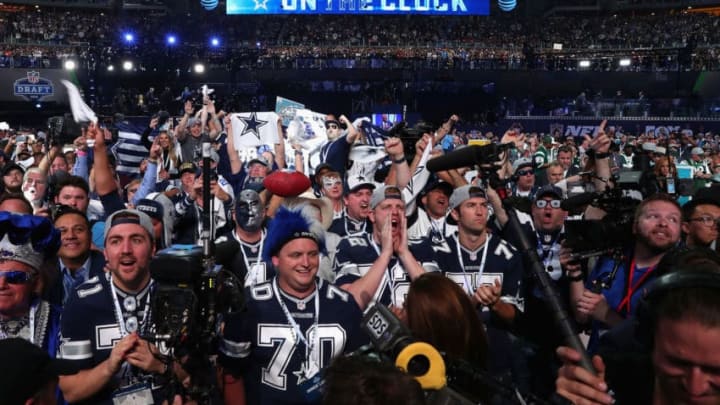The Dallas Cowboys made a decision to not take a wide receiver in the first round of the NFL draft. That puzzled some but here is why that it made sense.
The Dallas Cowboys had a plan all along at drafting wide receivers and all you had to do was look at several factors heading into the 2018 NFL draft. The primary of which being the strength of the draft class coming in which tends to vary wildly throughout the years.
But also it comes down to how they addressed the position in free agency and what schematically these players coming in can do. But first, let’s take a look at some previous wide receiver draft classes and see if we spot any significant trends.
The last time the Dallas Cowboys drafted a wide receiver in the first round was in 2010. Dez Bryant was selected as the 24th overall pick and that led to some pretty incredible value down the road. The only other wide receiver taken in the first round was Demaryius Thomas at 22. After eight years we can clearly state that Bryant had the better career so far (minus the Super Bowl title).
In 2011 three wide receivers were taken in the first round, A.J. Green, Julio Jones, Jonathan Baldwin. Green was taken fourth overall, Jones sixth, and Baldwin 26th. This shows just how well this draft class was evaluated by other teams as Green and Julio were indeed the best prospects at the position and worth such a high selection but as we can see in the years after this has not been the case.
The 2012 and 2013 class only had one real star, DeAndre Hopkins who was taken at with the 27th pick in 2013 (which is an absolute steal). The player to go before him, Tavon Austin to the (former) St. Louis Rams with the 8th pick in the first round. Cordarrelle Patterson would round out the first round after being selected with the 29th pick.
The 2012 wide receiver class was just bad all around, Justin Blackmon fifth overall selection (who could be the biggest bust at wide receiver over the last 8 years), Michael Floyd who was taken at 13, Kendall Wright was taken at 20, and AJ Jenkins was selected at 30.
None of those players ever reached the lofty heights they were supposed to achieve and most of them are out of the league already. The next “great” wide receiver class came in 2014 when the likes of Sammy Watkins (4th overall), Mike Evans (7th overall), Odell Beckham Jr (12th overall), Brandin Cooks (20th overall), and Kelvin Benjamin (28th overall).
All of those players have been highly productive and should be in the league for years to come. OBJ may just be the best wide receiver in the game right now, and Evans and Cooks are forces to be reckoned with. The jury is still out of Benjamin but he has at least shown an ability to be productive at the next level.
In 2015-17 the best wide receiver in the draft class was either taken early in the first round or fell into the 20s. In 2015 Amari Cooper was selected at the fourth spot, everyone else taken after that has underwhelmed or struggled to stay on the field. In 2017 Mike Williams went 7th in between Corey Davis (5th overall) and John Ross (9th overall).
Williams should have a breakout season this year. 2016 was the only anomaly as all of the top wide receivers went between 15-23 and the best one out of the bunch turned out to be Will Fuller who was selected at 21. So why didn’t the Dallas Cowboys reach and grab the best wide receiver available?
Well because the talent/value of the players at the position did not matchup up with where they would be drafted. D.J. Moore and Calvin Ridley were absolute hype machines. Both were expected to go fairly early and it was a shock they fell as far as they did.
More from Dallas Cowboys
- West coast, Texas coast, burnt toast: Cowboys don’t need more runs
- Brandin Cooks will change the way defenses play the Dallas Cowboys
- Why the Dallas Cowboys defensive X-Factor is EDGE Sam Williams
- Dallas Cowboys: 3 head coach options if McCarthy fails in 2023
- Dallas Cowboys: Is CB Jourdan Lewis a tradeable asset?
Both players had a late first round grade on them and realistically it is not drafting the best player available if you are reaching because of a need. There are at hundreds of examples about why you should not take a wide receiver earlier unless they are a. a physical specimen unlike any other player, b. fast with incredible hands, c. a highly productive player coming out of a good program, d. all of the above.
Players like Julio Jones and AJ Green don’t just appear out of thin air, teams know how good they are. That is why when there is an obvious lack of talent at the position, teams know when to stay away. The Dallas Cowboys addressed the wide receiver position already this offseason acquiring Allen Hurns and Deonte Thompson.
This made them feel as if drafting a receiver in the first or second round would be a bit too ambitious for their liking. They recouped immense value in selecting Michael Gallup in the third (a player a lot of analysts had as their second or third best receiver in this class).
Next: Dallas Cowboys: Are the Cowboys better or worse following the draft?
Over the last three years, only one wide receiver has been productive in the first season of their NFL career and that was Will Fuller. The Dallas Cowboys clearly saw this and wanted to stay away from adding ineffective starters for what could be a crucial 2018 season.
